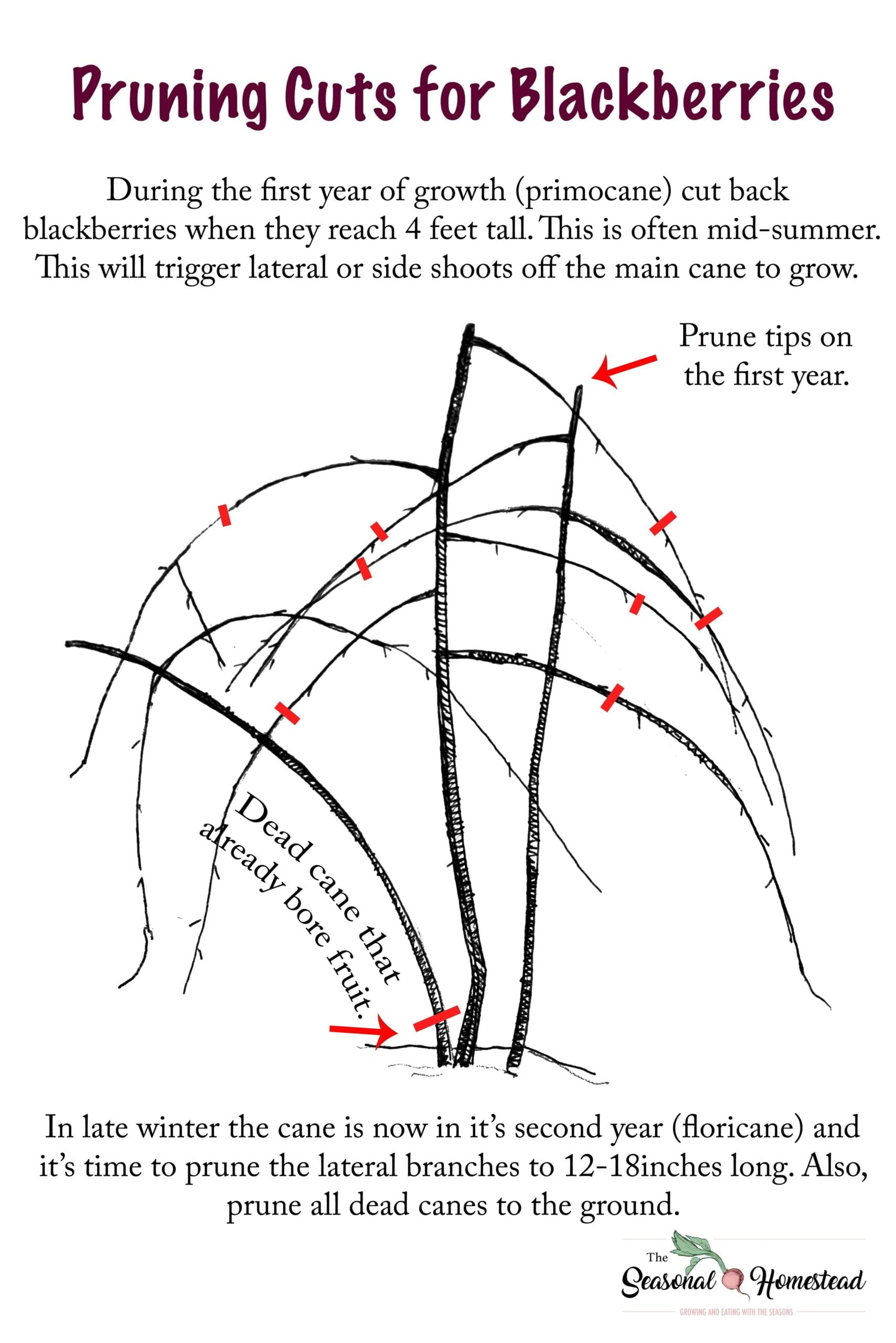Blackberries are a delicious and versatile fruit that many of us enjoy. But did you know that proper pruning is essential for maintaining healthy plants and maximizing yields? In this article, we will take you through a step-by-step guide to pruning blackberries, ensuring that your plants thrive and produce an abundance of juicy berries. Whether you are a seasoned gardener or a beginner, these simple tips and techniques will help you achieve a bountiful harvest. So grab your pruners and let’s get started on this exciting journey to maintain vibrant and fruitful blackberry plants!
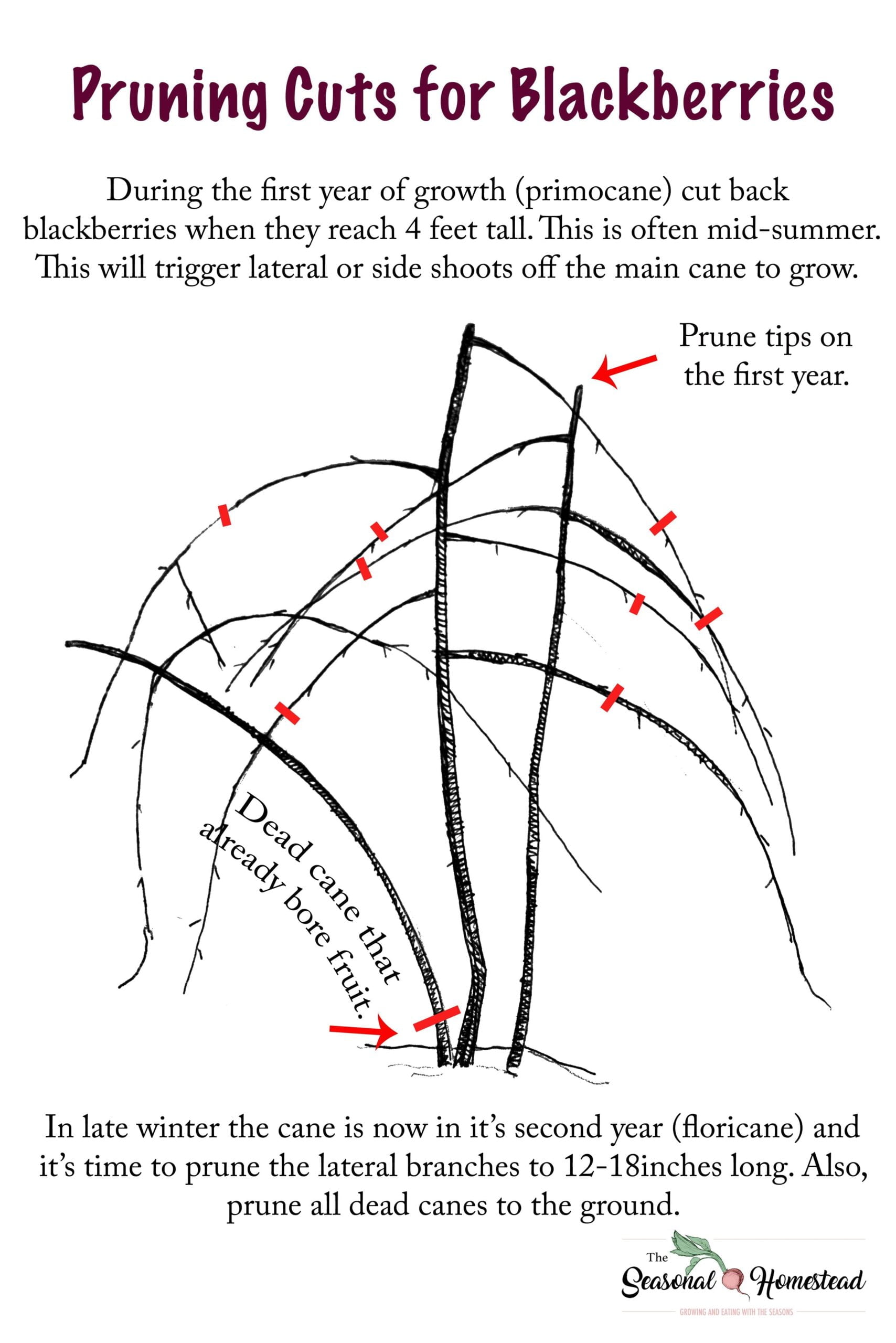
Choosing the Right Time to Prune
Understanding the Growth Cycle
To effectively prune blackberry plants, it is important to understand their growth cycle. Blackberries are perennial plants that undergo a two-year growth cycle. The first year, known as the primocane year, is when new canes or shoots emerge from the ground. These canes grow and develop foliage but do not produce fruit. In the second year, known as the floricanes year, the canes from the previous year mature and bear fruit. Understanding this growth cycle will help you determine the ideal time to prune your blackberry plants.
Determining the Ideal Pruning Time
The ideal time to prune blackberry plants depends on the specific variety and your geographical location. As a general rule of thumb, it is best to prune blackberries during late winter or early spring while the plants are dormant. This allows you to remove any dead or diseased canes and shape the plant before new growth begins. However, it is important to consult local gardening resources or contact your extension office to determine the precise pruning time for your specific blackberry variety in your region.
Preparing for Pruning
Gathering the Necessary Tools
Before you start pruning, gather all the necessary tools. These include a pair of quality bypass pruners or loppers for cutting through thick canes, a pair of sharp handheld shears for more precise trimming, and a sturdy pair of gloves to protect your hands from thorns. It is important to use sharp tools to ensure clean cuts and minimize damage to the plant.
Ensuring Safety Measures
Pruning blackberry plants can be a prickly process, so it’s important to take safety precautions. Wear long-sleeved shirts, long pants, and closed-toe shoes to protect yourself from scratches and thorns. Additionally, consider wearing safety glasses to shield your eyes from any debris that may fly during pruning.
Cleaning and Sterilizing Tools
Before you commence pruning, it’s crucial to clean and sterilize your pruning tools. This prevents the transmission of diseases between plants and reduces the chances of infecting the wounds on the blackberry canes. Use a solution of water and household bleach or rubbing alcohol to disinfect your tools. Simply soak the blades for a few minutes, rinse them off, and allow them to air dry before use.
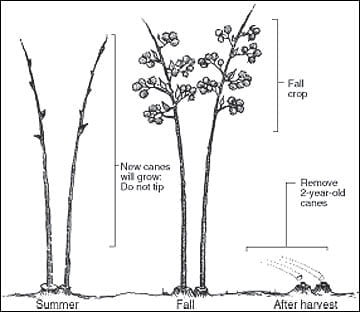
Pruning Basics
Identifying Canes
Before you can properly prune blackberry plants, it’s essential to be able to identify the canes. Canes are the long, flexible stems that originate from the plant’s base. They can either be primocanes or floricanes, depending on their age. Primocanes are the new, green shoots that emerge from the ground each year, while floricanes are the mature canes that have already produced fruit.
Removing Dead and Diseased Canes
One of the first tasks when pruning blackberries is removing any dead or diseased canes. These canes are often dry, brittle, discolored, or have signs of fungal growth. By removing them, you not only improve the overall health of the plant but also prevent the spread of diseases to other healthy canes.
Cutting Back Primocanes
To encourage proper branching and fruiting, it is crucial to cut back the primocanes. Once the canes reach a height of around three to four feet, it is recommended to prune or tip prune the top 6-8 inches. This stimulates lateral growth and helps develop a strong framework for the blackberry plant.
Maintaining a Healthy Canopy
When pruning blackberries, it is important not to remove too much foliage as leaves are essential for photosynthesis. While it is necessary to thin out overcrowded canes, maintain a balance by leaving enough healthy foliage to ensure the plant receives maximum sunlight for optimal growth and fruit production.
Pruning Techniques
Tip Pruning
Tip pruning involves cutting off the top portion of the primocanes, stimulating the growth of lateral branches. By removing the terminal buds, you encourage the development of side shoots, resulting in a bushier and more productive blackberry plant.
Heading Back
Heading back refers to cutting back the laterals or side branches on the canes. This technique is particularly helpful for managing unruly canes that have grown too long or are interfering with neighboring plants. Heading back can also help improve air circulation within the plant, reducing the risk of diseases.
Thinning Out
Thinning out the canes involves selectively removing overcrowded or weak canes. This technique improves air circulation, reduces competition for sunlight, and allows the remaining canes to grow stronger and produce larger berries. When thinning out, remove the canes at their base, taking care not to damage the remaining healthy ones.
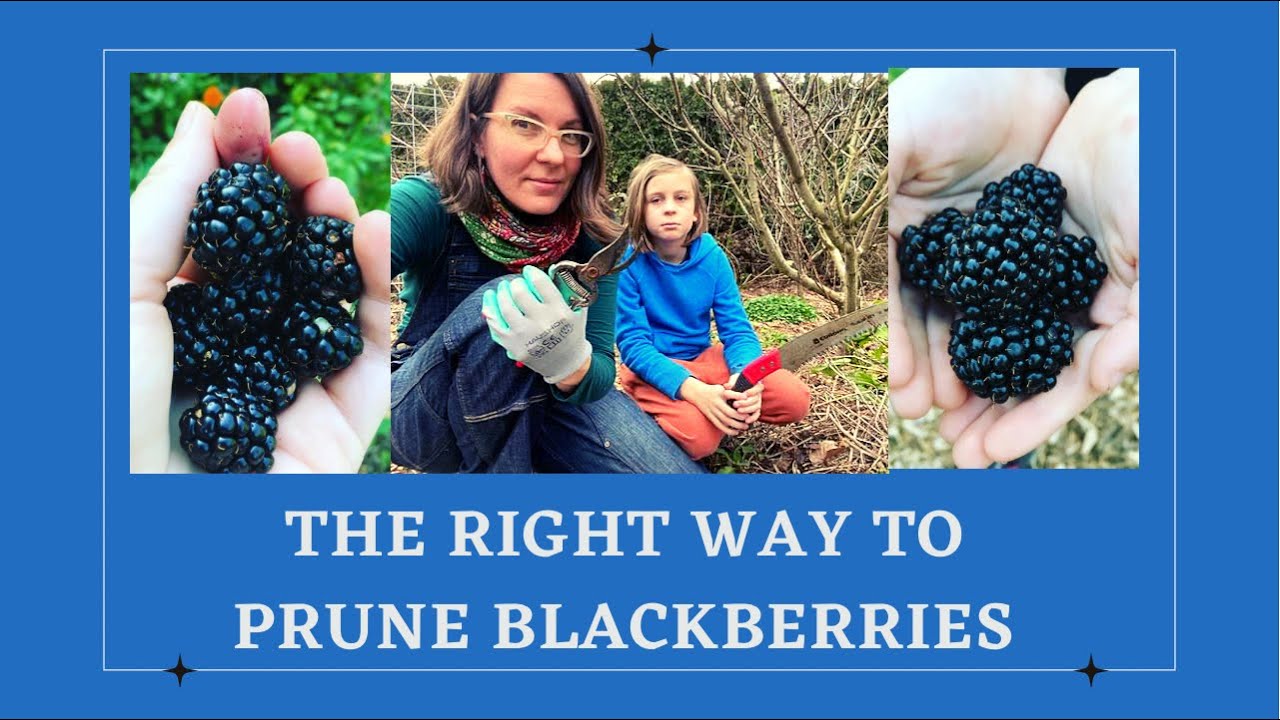
Pruning Young Blackberry Plants
Establishing the Plant
When planting young blackberry plants, it is crucial to establish a strong framework from the beginning. Before the first winter, trim the primocanes to about 24 inches in height to promote branching and new growth. This initial pruning sets the foundation for a healthy plant and ensures better productivity in the following years.
Pruning in the First and Second Year
During the first and second year, focus on shaping the blackberry plant by performing light pruning. Remove any dead or damaged canes and thin out overcrowded canes to promote good airflow. Keep in mind that fruit production will be limited during the first two years, so the primary goal is to establish a strong, well-structured plant.
Shaping the Plant for Future Growth
In the third year and beyond, the blackberry plant should have a well-established framework. At this stage, the focus shifts to shaping and maintaining the plant for optimal growth and fruit production. Prune to remove dead canes, thin out overcrowded canes, and promote new growth by tip pruning and heading back as needed.
Pruning Established Blackberry Plants
Assessing the Plant’s Condition
Before pruning established blackberry plants, take time to assess their overall condition. Identify any damaged or diseased canes, as well as canes that have already produced fruit and are approaching the end of their life cycle. By evaluating the plant’s condition, you can tailor the pruning approach to maximize growth and fruit production.
Cutting Down Old Canes
To rejuvenate established blackberry plants, it is essential to cut down the old canes that have already borne fruit. These floricanes will not produce berries again and can hinder airflow and sunlight penetration. Cut them down to ground level, making clean cuts just above the soil line to prevent any stubble that could invite pests and diseases.
Promoting Air Circulation
Good airflow is important for blackberry plants as it helps prevent the development and spread of diseases. Thin out any canes that are growing too close together or crossing over each other. This will create space between the canes, allowing for better air circulation and reducing the risk of fungal infections.
Managing Suckers
Blackberry plants are known to produce suckers or shoots that emerge from the base of the plant. While some suckers may develop into productive canes, it is essential to manage their growth to prevent overcrowding and competition for resources. Remove any unwanted suckers at ground level to maintain a well-spaced and productive blackberry plant.
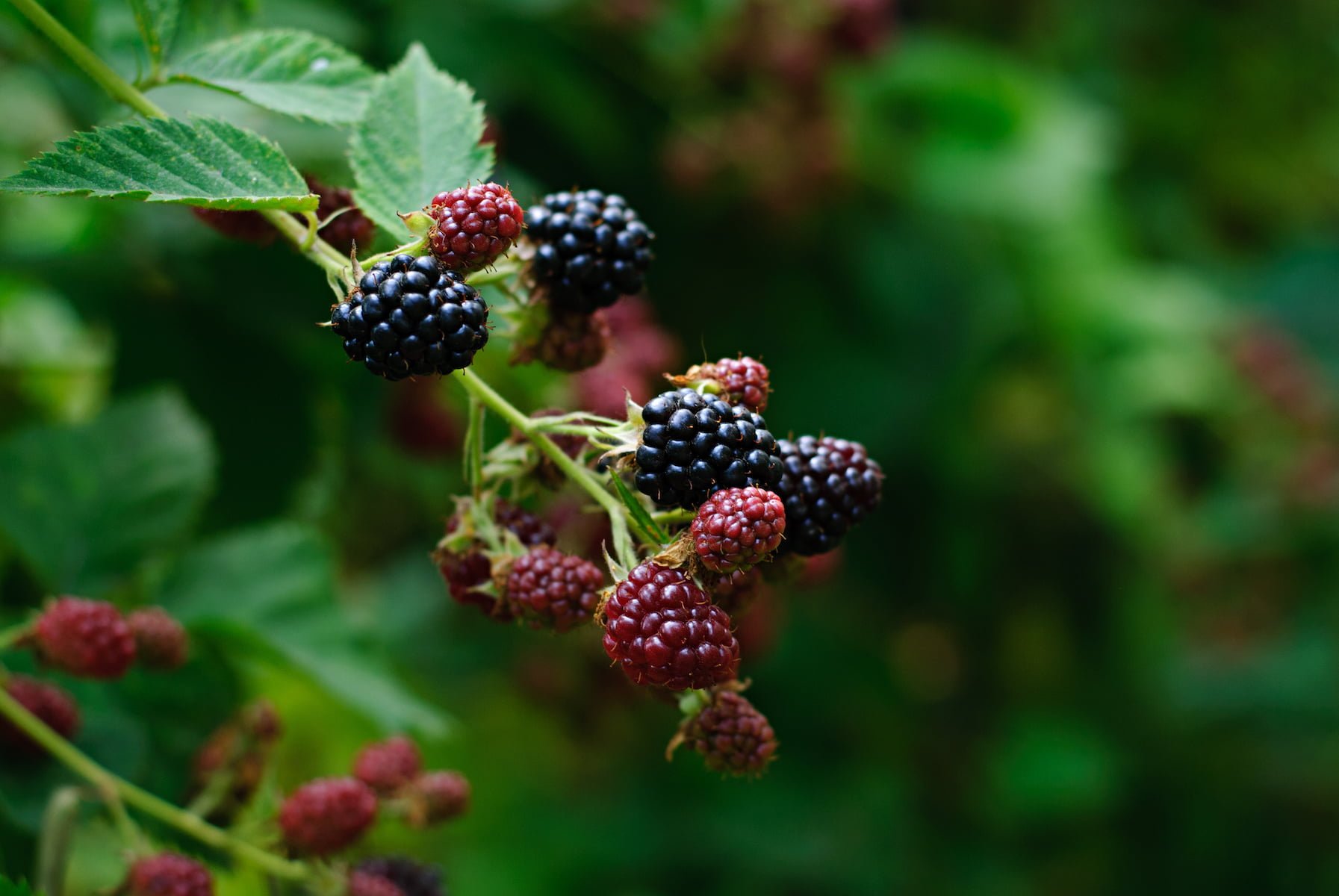
Training Blackberry Plants
Trellising Techniques
Training blackberry plants on a trellis system helps maximize space and ease the pruning process. Install trellises or supports before the plants’ growth begins to provide a structure for the canes to climb and spread out. This allows for better access to sunlight, air circulation, and easier pruning and harvesting.
Supporting Canes
As blackberry canes grow, they become heavier and may need support to prevent bending or breaking. Use flexible ties, such as garden twine or soft plant ties, to gently secure the canes to the trellis or support structure. This ensures upright growth and reduces the risk of damage during windy conditions or heavy fruiting.
Encouraging Upright Growth
To maintain an upright growth habit, train the blackberry canes by gently bending and securing them to the trellis wires. This will help prevent the canes from sprawling on the ground, which can make pruning and harvesting difficult. By encouraging upright growth, you create a more organized and manageable blackberry plant.
Pruning for Optimal Yield
Regular pruning plays a crucial role in achieving optimal yield from blackberry plants. By removing old, diseased, or overcrowded canes, you direct more energy and resources towards the remaining healthy canes. This promotes better fruit set, larger berries, and overall improved productivity.
Pruning Primocanes
Understanding Primocanes
Primocanes are the new canes that emerge from the ground each year. During their first year, primocanes do not produce fruit and focus on establishing a strong root system and leaf growth. Understanding the growth pattern of primocanes is key to properly pruning and managing blackberry plants.
Timing the Pruning
Pruning primocanes should be done in late winter or early spring, just before new growth begins. It is important to prune before bud break to minimize stress on the plant and allow sufficient time for the new canes to develop. Timing the pruning correctly ensures the blackberry plant will produce healthy and vigorous canes for the coming season.
Selective Pruning for Primocanes
Selective pruning is crucial for primocanes to encourage branching, increase fruiting potential, and maintain an open canopy for light penetration. Aim to remove weak or damaged canes, as well as any that are growing too close together. Leave the healthiest and most vigorous canes to thrive and produce a bountiful harvest.
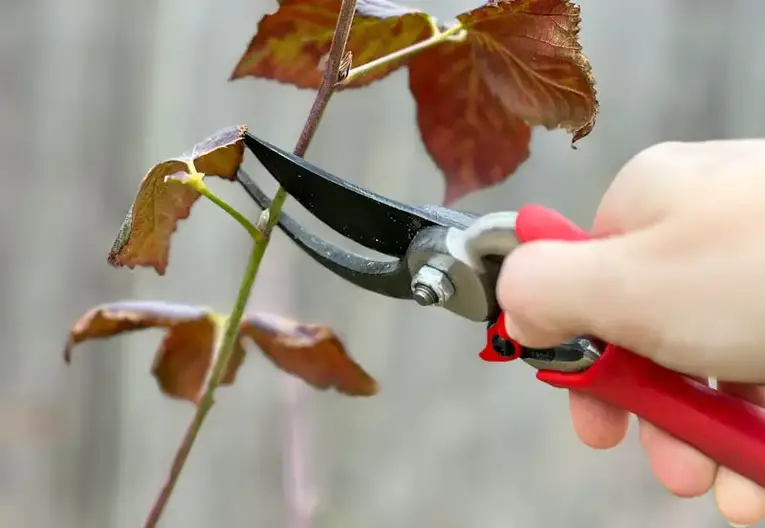
Dealing with Pests and Diseases
Identifying Common Blackberry Pests
Blackberry plants may attract various pests, including aphids, spider mites, raspberry crown borers, and Japanese beetles. Regularly inspect your plants for signs of infestation, such as mottled leaves, distorted growth, or visible pests. Identifying the specific pests affecting your blackberries is crucial for implementing effective control measures.
Prevention and Control Measures
To prevent pest infestations, practice good garden hygiene by keeping the area around your blackberry plants clean and free from debris. Additionally, encourage natural predators, such as ladybugs and lacewings, by providing them with habitat and avoiding the use of broad-spectrum pesticides. For severe infestations, consider using organic insecticides specifically formulated for blackberries.
Pruning to Mitigate Disease Spread
Blackberry plants can be susceptible to fungal diseases, including cane blight, anthracnose, and botrytis fruit rot. Pruning plays a vital role in managing and mitigating the spread of these diseases. Remove any diseased canes, ensuring clean cuts well below the infected area. This helps prevent the spread of spores and promotes overall plant health.
After Pruning Care
Applying Fertilizer
After pruning, it is beneficial to apply a balanced fertilizer to provide essential nutrients to the blackberry plants. Use a slow-release fertilizer formulated for berries or a general-purpose fertilizer with a balanced N-P-K ratio. Follow the manufacturer’s instructions for application rates, and avoid over-fertilizing, as it may lead to excessive vegetative growth and reduced fruit production.
Mulching the Soil
Mulching is an excellent practice to conserve soil moisture, suppress weed growth, and provide insulation to the roots of blackberry plants. After pruning, apply a layer of organic mulch, such as straw or wood chips, around the base of the plants. This helps maintain soil moisture levels and protects the roots from extreme temperature fluctuations.
Watering and Irrigation
Proper watering is crucial after pruning to ensure the blackberry plants recover and thrive. Water the plants thoroughly, especially if rainfall is insufficient. Provide deep, regular waterings to encourage healthy root development and support the growth of new canes.
Monitoring Regrowth
After pruning, closely monitor the regrowth of blackberry plants. Keep an eye out for any signs of stress, disease, or nutrient deficiencies. Regularly inspect the canes, foliage, and fruits to detect any issues early on. By being vigilant and addressing any problems promptly, you can ensure the continued health and productivity of your blackberry plants.
In conclusion, pruning blackberries is an essential task for maintaining healthy and productive plants. By understanding the growth cycle, gathering the necessary tools, and following proper pruning techniques, you can shape the plant, promote airflow, and maximize fruit yield. Whether you are working with young or established blackberry plants, regular pruning, training, and proper care will result in healthy canes, abundant fruit, and a bountiful harvest. Remember to always prioritize safety, consult local resources for specific instructions, and enjoy the rewarding process of pruning your blackberry plants. Happy pruning!
